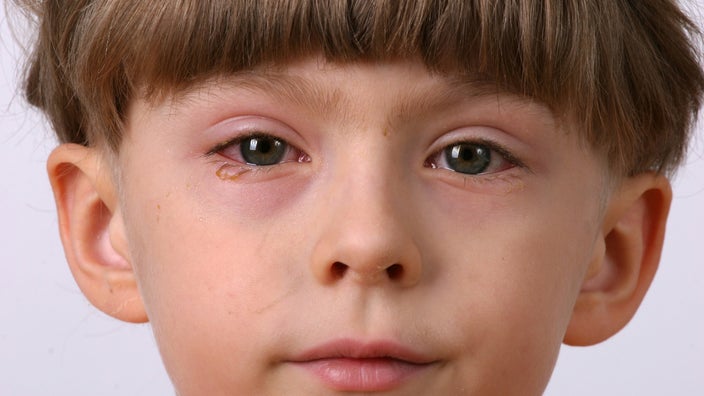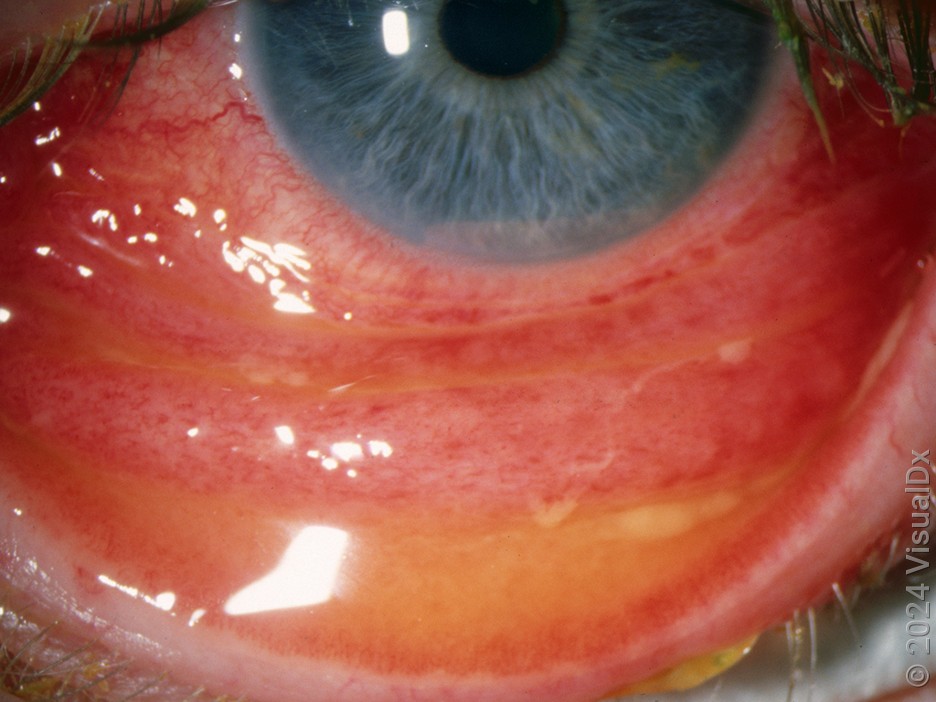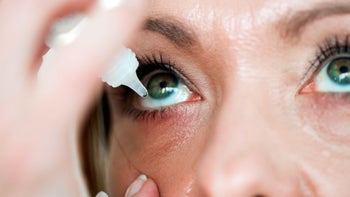
What Is Pink Eye? Causes, Treatment, and Pictures
Key takeaways:
Pink eye (conjunctivitis) is an inflammation or infection of conjunctiva, the lining inside the eyelid and over the front of the eye.
Symptoms of pink eye include eye redness, as well as discharge, swelling, and itching.
There are several causes of pink eye. Bacterial pink eye should be treated with antibiotics. But pink eye caused by viruses will go away on its own.
Table of contents

Most people develop conjunctivitis (pink eye) at some point. Whether you’ve woken up to find your eyes gunked shut or dealt with nonstop eye discharge, you know that pink eye can be uncomfortable and disruptive. It can be hard to know if you need treatment for pink eye or if you should just wait it out.
If you’re currently dealing with conjunctivitis — or you just want to be prepared for next time — here are three things that could be causing your pink eye and what you need to do about it.
What is pink eye?
Pink eye (conjunctivitis) is an inflammation or infection of conjunctiva. The conjunctiva is the clear lining inside the eyelid and over the front of the eye.
Search and compare options
When the conjunctiva is inflamed, it gets red and swollen. This gives your eye a pink and puffy appearance. Inflammation and infection can lead to other symptoms, too, like eye discharge.
What are the symptoms of pink eye?
Symptoms of pink eye can vary from person to person. Some common pink eye symptoms include:
A burning or gritty sensation in the eye
Eye crusting in the morning
Watery or stringy eye discharge through the day
Mild eye itching
Eye redness
Eyelid redness
Eyelid swelling
Your symptoms may vary depending on what’s causing your pink eye.
What does pink eye look like?
Pink eye can look different depending on what’s causing it. Bacterial pink eye is usually more dramatic than pink eye caused by viruses or allergies.
Early stages of pink eye are usually less obvious. You may only notice mild redness or swelling. Over 1 to 2 days, you may experience more noticeable symptoms and eye discharge.
Pink eye causes swelling and redness of the lining of the eyelid, which is also part of the conjunctiva. You can see these changes if you gently pull down on your lower eyelid.


Quiz: Do you have pink eye?
What causes pink eye?
The three most common causes of pink eye are viruses, bacteria, and allergies.
1. Viruses
Viruses can infect the conjunctiva. When this happens, it’s called viral conjunctivitis. The viruses that cause conjunctivitis are more active during the summer months. And they pass easily from one person to another through respiratory droplets and contaminated objects and surfaces.
Many times, people with viral conjunctivitis have symptoms of a common cold, too, like coughing and congestion. Viral conjunctivitis usually starts in one eye, with the other eye getting red about 1 to 2 days later.
Timeline for pink eye: How long pink eye lasts depends on the cause.
Seeking relief? Our experts review the best ways to get rid of pink eye fast.
Pink eye can spread quickly. Here’s how long you’re contagious with pink eye.
2. Bacteria
Bacteria can infect the conjunctiva, too. Usually, people only develop pink eye in one eye if they have bacterial conjunctivitis. Bacterial conjunctivitis also tends to cause more dramatic symptoms, like more severe eyelid swelling and redness. Other symptoms include:
Stiff eyelid crusting that makes it difficult to open your eyes in the morning
Thick, gunky discharge during the day that can be green, yellow, or white
Eye discharge that quickly accumulates at the corner of the eye when you wipe your eye
Bacterial conjunctivitis is a common cause of pink eye in kids. Children with bacterial pink eye may also have an ear infection at the same time. It’s more likely to develop bacterial conjunctivitis during the winter and early spring. And, like viruses, bacteria also pass easily from person to person through respiratory droplets and contaminated objects and surfaces.
Read more like this
Explore these related articles, suggested for readers like you.
3. Allergies
Allergies are the most common cause of pink eye. Some studies estimate that 40% of people experience allergic conjunctivitis.
Allergic conjunctivitis develops in the spring and summer months when seasonal allergies start to act up. You can also develop allergic conjunctivitis if something you’re allergic to (like pet dander, for example) gets into your eye.
People usually develop conjunctivitis in both eyes if their pink eye is from allergies. People experiencing allergic conjunctivitis also have other symptoms of seasonal allergies — like sneezing, congestion, and runny nose — at the same time as pink eye.
How is pink eye diagnosed?
Most people can tell they have pink eye by looking at their eyes in the mirror. You can usually see signs of pink eye, like eye redness or eyelid swelling. You can also feel itchiness and discomfort and see eye discharge.
But other things can also cause symptoms similar to pink eye, including:
Eye irritation from smoke or chemicals
Something getting stuck in your eye, like a bit of dust or grit
Eyelid infections
Seek medical care if you’re not sure whether or not you have pink eye. An eye doctor can perform an eye exam to figure out whether you have pink eye or if something else is causing your symptoms.
How do you treat pink eye?
Treatment for pink eye depends on what’s causing it. But, no matter what’s causing your pink eye, things that can help ease your symptoms include:
Warm compresses
Cool compresses
Eye wipes
Viral conjunctivitis treatment
Viral conjunctivitis goes away on its own. But it can take up to 3 weeks for your eyes to completely return to normal. Unfortunately, antibiotic eye drops won’t help symptoms go away any faster.
But you can try using over-the-counter artificial tears along with cool compresses to help ease your symptoms.
Bacterial conjunctivitis treatment
About half the time, bacterial conjunctivitis goes away on its own over 2 or 3 weeks. The rest of the time, people need antibiotic eye drops — and sometimes antibiotics by mouth — to clear the infection. Studies show that antibiotics make the symptoms of pink eye go away faster. So, most people opt to start treatment rather than waiting.
Popular antibiotic eye drops include:
Ciprofloxacin
Ofloxacin
Erythromycin ointment
You’ll place a few drops in each eye between 4 to 6 times per day for a week. You can also use warm and cool compresses to help ease symptoms.
Allergic conjunctivitis treatment
Pink eye from allergies goes away on its own once you’re no longer around the allergen. You may not need any treatment if you’re only going to be around an allergen briefly.
But, if you have seasonal allergies, it might take weeks or months for your allergen to go away. Most people with allergic conjunctivitis from seasonal allergies opt to start treatment. Treatment can help ease symptoms during your allergy season.
Treatment options include:
When should you seek medical care for pink eye (conjunctivitis)?
Since pink eye can go away on its own, it can be reasonable to take a “wait-and-see” approach. But there are some situations where you don’t want to wait to make an appointment with a healthcare professional, like the scenarios below.
You have vision changes
You shouldn’t have vision changes because of pink eye. Never wait to see an eye doctor if you experience a sudden change in your vision, since it can be a sign of a serious eye problem.
You have worsening symptoms
You should see a healthcare professional if you develop light sensitivity, eye pain, or your symptoms are getting worse over time.
You have shingles or herpes
If you’re having a shingles or herpes outbreak and develop pink eye, see a healthcare professional right away. You’ll want to make sure the infection isn’t spreading to your eye. Unlike other types of viral conjunctivitis, eye infections from herpes and shingles can cause permanent eye damage and vision loss.
You wear contact lenses
See an eye doctor right away if you wear contact lenses and develop eye redness, swelling, or discharge. People who wear contact lenses can develop a severe eye infection called keratitis, which can cause vision loss. Since keratitis and pink eye may look and feel the same, the only way to tell them apart is with an eye exam.
You’re not sure if it’s pink eye
If you’re on the fence about whether your eye symptoms are from pink eye, see a healthcare professional. You don’t want to miss a more serious eye infection, like preseptal cellulitis (infection of the eyelid itself). If you have other eye conditions, like dry eye or uveitis, it’s best to see a healthcare professional to make sure your condition isn’t worsening or flaring.
You got something in your eye
Getting something stuck in your eye can cause symptoms that are similar to pink eye, like swelling, redness, and discharge. Even something as small as a grain of sand can cause symptoms. So, if there could be something in your eye, get an eye exam. An eye doctor can remove it before it causes a corneal abrasion or ulcer.
You need a note to return to work or school
Since pink eye can be contagious, many places require a note from a healthcare professional stating that it’s safe for you to go back to work or school. If that’s the case, you’ll need to check in with your eye doctor to get back to your usual schedule. Ask if they’re willing to do a telehealth appointment, which can save you time and energy.
Frequently asked questions
Other eye conditions that cause eye discomfort, itching, or redness can be misdiagnosed as pink eye. Some examples include dry eye syndrome, blepharitis, or eye irritation from smoke and fumes.
You’ll stop being contagious 24 hours after starting antibiotic eye drops for bacterial conjunctivitis. Without antibiotic treatment, people with bacterial pink eye are contagious for about a week.
You can avoid spreading pink eye to others by washing your hands frequently. Avoid touching your eyes, nose, and mouth, so you don’t spread viruses and bacteria to surfaces. You can also avoid spreading pink eye by starting treatment with antibiotic eye drops if you have bacterial conjunctivitis.
The bottom line
Conjunctivitis, or pink eye, is a condition that causes eye redness, swelling, and discharge. The most common causes of pink eye are allergies, viral infection, or bacterial infection. Many people with pink eye get better on their own, even without treatment. But there are treatments — both prescription and over-the-counter options — that can provide symptom relief.
Why trust our experts?


Images used with permission from VisualDx (www.visualdx.com).
References
Azari, A. A., et al. (2013). Conjunctivitis: A systematic review of diagnosis and treatment. JAMA.
Centers for Disease Control and Prevention. (2024). Pink eye: Causes and how it spreads.
Solano, D., et al. (2023). Viral conjunctivitis. StatPearls.
Vyas, J. M., et al. (2023). Periorbital cellulitis. MedlinePlus.





























